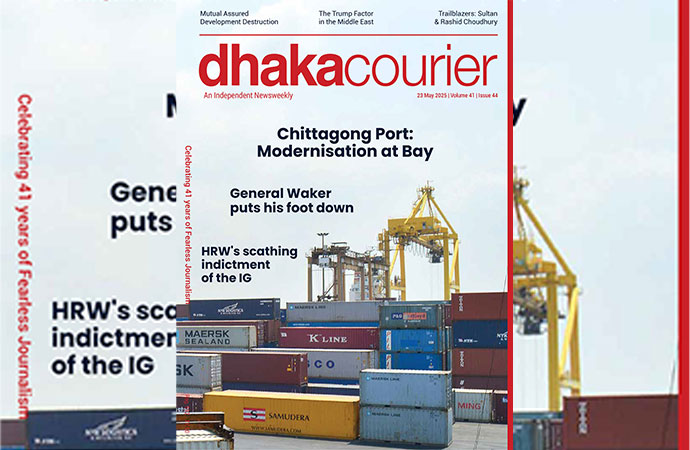Technology

Photo: Karim Waheed
In the late 1970s, Shenzhen was a modest fishing village, tucked away in the southern tip of Guangdong Province, China. With a small population, it was an unlikely candidate for economic stardom. Fast forward to the present day, and Shenzhen has metamorphosed into a bustling metropolis with a population exceeding 17 million - known globally as a hub of innovation and technology.
This transformation is a cornerstone of China's economic reform and a testament to the power of strategic vision and policy.
Shenzhen's remarkable transformation is showcased at the city's Reform and Opening-up Exhibition Hall, which we, a team of visiting Bangladeshi journalists, explored on April 21. Our subsequent tours of Huawei and Mindray Medical International Limited headquarters on the following day further reinforced our impressions of the city's rapid development and technological prowess.
The Catalyst of Change: Economic Reform Policies
The pivotal moment for Shenzhen came in 1980 when it was designated as China's first Special Economic Zone (SEZ) by Deng Xiaoping's government. This designation intended to attract foreign investment and test market reforms. Shenzhen's proximity to Hong Kong, a global financial hub, made it an ideal testbed for these reforms.
The SEZ status conferred unprecedented autonomy on the city in economic decision-making, Tax incentives, fewer bureaucratic steps, and market-oriented business environment catalyzed an influx of foreign investments.
Infrastructure and Industrialization: Laying the Foundation
Concurrent with policy reforms, Shenzhen's infrastructure underwent a dramatic overhaul. The government invested heavily into building roads, ports, railways, and telecommunications networks, drastically enhancing the city's connectivity and efficiency. The establishment of the Shenzhen Stock Exchange in 1990 further positioned the city as a financial center.
Industrial parks sprang up around the city, attracting manufacturing units from electronics to pharmaceuticals. The move from a primary focus on manufacturing to include high-tech industries was signalled by giants like Huawei and Tencent establishing their headquarters in Shenzhen. This not only diversified the city's industrial base but also elevated its status to that of a global technology nexus.
Innovation and Talent Attraction: Fuelling Sustained Growth
Shenzhen's policies have always favored innovation and creativity. The city is now renowned for its robust intellectual property protections which has made it attractive for tech startups and entrepreneurship. In addition, Shenzhen invests heavily in education and R and D, drawing talents from across the globe to its research institutes and think tanks.The city's rapid economic expansion is also supported by a unique culture that encourages experimentation and innovation. This is embodied in the landscape of sprawling tech campuses and vibrant startup incubators that dot the city.
Huawei's Robust Growth Amid Diverse Innovations
Huawei Technologies Co. Ltd., a global leader in information and communication technology (ICT) and smart devices, reported a robust revenue of US$97 billion for the year 2023. This financial milestone was prominently fueled by the company's ICT technology infrastructure, which constituted half of the total revenue.
In a strategic push to spearhead technological advancements, Huawei invested a substantial 23.4% of its annual revenue into research and development (R and D) in 2023.
It also marked a year of solid performance for Huawei's core ICT infrastructure operations, while its consumer business achieved its set targets efficiently. The company's forays into cloud computing and digital power sectors reported steady growth. Notably, Huawei's intelligent automotive solution business commenced large-scale deliveries, signaling a promising diversification strategy that aligns with global digital transformation trends.
Mindray's Global Impact Through Innovative Medical Technologies
During a visit to Mindray, a multinational leader in medical instrumentation, we explored the company's comprehensive product range across its principal business segments: Patient Monitoring and Life Support, In-Vitro Diagnostic Products, and Medical Imaging Systems.
Founded in 1991, Mindray has established itself as a foremost provider of medical devices and solutions worldwide. With a robust global network encompassing R and D, marketing, and service, Mindray exemplifies innovation that is both advanced and accessible.
Mindray's commitment to transforming cutting-edge technologies into practical healthcare solutions allows its products to permeate medical facilities in over 190 countries and regions including Bangladesh.
Understanding the Shenzhen Success Story
During a banquet at Futian Shangri-La, Ms. Cao Saixian, Director General of the Shenzhen Foreign Affairs Office, detailed the city's remarkable transformation into an economic powerhouse. Ms. Lin Huaqi, Chief of the Division of Globalization Promotion, also participated in the discussion.
Ms. Cao highlighted how Shenzhen attracts young talent from across China, providing a model of economic development that could serve as a blueprint for global economic transformation. She emphasized the city's innovative policies and strategic initiatives that have been central to its success.
The visits were part of a media trip to China - from April 18 to 24 - facilitated by the Chinese Embassy in Dhaka.
From Guangzhou, China

























Leave a Comment
Recent Posts
Harrowing stories of rescue em ...
In the frantic hours after a wall of water engulfed camps and homes in ...
On the chin: Trump’s tariff a ...
The 90-day pause on Donald Trump’s radical restructuring of Amer ...
Reimagining the OST: ‘Utshob’ is an ode to the 90s, ..
‘Married to Journalism’: Adieu to Shamim Ahmad
The High Court released the full text of its judgmen ..
Chipmaker Nvidia became the first public company to ..